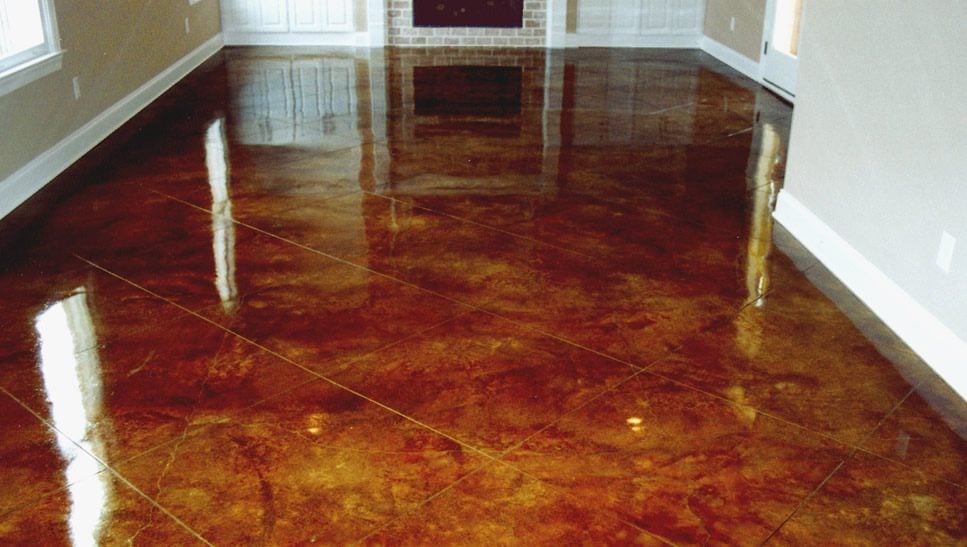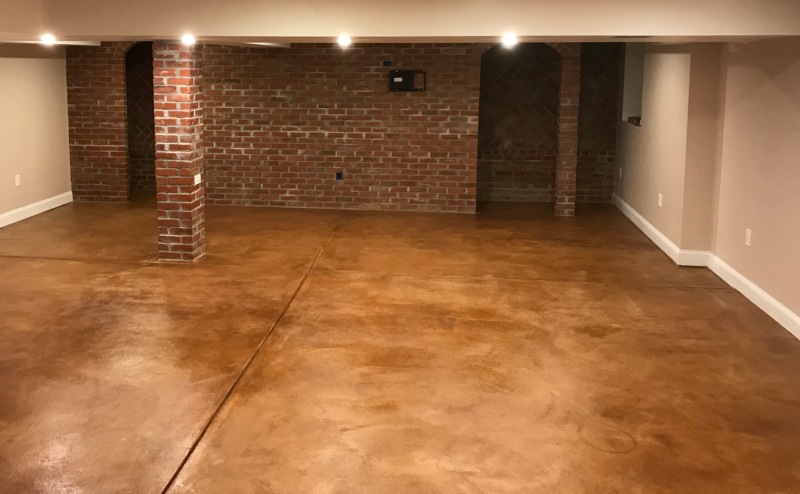Why designers in Austin love stained concrete austin
Wiki Article
Recognizing the Various Kinds Of Stained Concrete for Your Following Project
Stained concrete deals different choices that deal with different aesthetic and functional demands. Each type offers unique features that influence the last appearance and sturdiness of the surface. Understanding these distinctions is key for any person intending a project. From rich, chemical responses of acid-based stains to the vibrant uniformity of strong color stains, the selections can considerably affect the end result. What elements should one think about when choosing the perfect stain for their certain demands?Review of Stained Concrete
Stained concrete works as a functional flooring option that can enhance the aesthetic charm of numerous spaces. This method involves using a coloring agent to the surface area of existing concrete, enabling a broad spectrum of design opportunities. Stained concrete is prominent in both property and business settings, using a resilient and low-maintenance solution that can mimic the appearance of natural products like stone or ceramic tile.The staining procedure can be carried out using water-based or solvent-based items, each giving distinctive visual results. The last look is affected by aspects such as the initial concrete surface area, the sort of tarnish used, and the application approach. Stained concrete not only improves interiors and outsides but additionally advertises sustainability by rejuvenating existing concrete structures. Because of this, it has gained traction among home owners and developers looking for both performance and design in their flooring selections.
Acid-Based Stains: Features and Benefits

Distinct Color Variations
Concrete surfaces can transform drastically with the application of acid-based stains, which offer a rich combination of special shade variants. These stains pass through the concrete, responding chemically to produce vibrant planet tones that range from deep browns and reds to soft greens and blues. The resulting tones are often variegated, producing a natural, marble-like appearance that boosts the concrete's personality. Each application yields distinct results as a result of variants in the concrete's structure and the staining technique made use of, making every task unique. Furthermore, acid-based stains can be layered or integrated with various other methods to develop personalized layouts, permitting personal expression. This versatility makes acid-based stains a preferred choice for both property and business applications.Chain Reaction Described
While several variables add to the performance of acid-based stains, the underlying chain reaction play a necessary duty in their one-of-a-kind qualities and advantages. These stains mainly contain water, acid, and metallic salts. When related to concrete, the acid reacts with the calcium hydroxide in the concrete, creating a chemical makeover that results in permanent color changes. The metallic salts pass through the surface area and bond with the concrete, permitting a variety of hues and tones. This response not only improves visual charm however additionally provides sturdiness, making the shade immune to fading and wear. Additionally, acid-based stains can produce a variegated surface that simulates all-natural stone, additional enhancing their appeal for ornamental concrete applications.Surface Area Preparation Relevance
Accomplishing suitable results with acid-based stains pivots on extensive surface area prep work. This vital action guarantees that the concrete surface is tidy, without impurities, and effectively profiled for perfect discolor absorption. Any kind of existing sealants, dirt, or oils can impede the chain reaction that generates the wanted shade and finish, causing uneven or uneven outcomes.Prior to applying the tarnish, the concrete should be mechanically cleaned or stress washed, adhered to by a comprehensive inspection for splits or flaws that may need repair service. Furthermore, validating the surface area is sufficiently dried out will certainly improve tarnish adherence. By focusing on these preparatory procedures, the durability and vibrancy of acid-based stains can be substantially enhanced, leading to a much more aesthetically pleasing and long lasting coating.
Water-Based Stains: Features and Advantages

Water-based stains penetrate the concrete, providing a more translucent finish that highlights the all-natural structure and variants of the surface under. They are available in a wide range of colors, permitting creative flexibility in layout. In addition, water-based stains are much easier to tidy up, needing just water and soap, which streamlines the application process.
Their quick drying time boosts efficiency, making them a sensible choice for both DIY lovers and specialists. Generally, water-based stains provide an enticing mix of visual versatility and straightforward homes, making them a preferred option for concrete enhancement jobs.
Strong Color Stains: Lively Choices for a Strong Appearance
Solid color stains supply an effective service for those looking for to create a bold and vivid visual on concrete surfaces. These stains give an uniform pigmentation that can substantially boost the visual appeal of floorings, patios, and driveways. Offered in a wide range of hues, solid shade stains enable creative expression, providing to numerous design choices.Among the essential benefits of solid shade stains is their ability to conceal blemishes, offering a fresh and polished aim to aging concrete - Austin Stained Concrete Floors. Additionally, their solution usually includes UV-resistant homes, guaranteeing durability and shade retention also in harsh climate condition
Application is simple, needing very little prep work of the concrete surface. As soon as applied, solid shade stains can be sealed for included security and shine, additional raising their aesthetic high quality. With their dynamic options, solid color stains are a superb option for those aiming for check here an impactful and natural layout.
Semi-Transparent Stains: Attaining Depth and Measurement
Semi-transparent stains provide an one-of-a-kind strategy to improving concrete surface areas by providing depth and dimension via different color alternatives. Comprehending the application strategies is necessary for achieving the wanted impact, while correct maintenance techniques ensure durability. This section will certainly explore these key facets to take full advantage of the advantages of semi-transparent staining.Color Options Available
A wide variety of color options exists for semi-transparent stains, enabling property owners and developers to improve the natural charm of concrete surfaces. These stains are available in a variety of tones, from natural tones like browns and terracottas to vibrant shades such as blues and environment-friendlies. The semi-transparent nature of these stains allows the underlying concrete to reveal through, producing a distinct deepness and dimension that can enhance different style looks. In addition, combining different shades can create custom shades, making it possible for a customized try to find each project. This flexibility makes semi-transparent stains a prominent option for both interior and exterior applications, as they can balance with surrounding aspects while adding visual passion to ordinary concrete.Application Techniques Discussed
To achieve the desired depth and measurement with semi-transparent stains, proper application techniques are crucial. Surface area preparation is essential; the concrete must be clean and cost-free of any impurities. This commonly entails power washing and repairing any type of cracks. Next, selecting the best applicator, such as a sprayer, roller, or brush, can influence the final look. Sprayers permit a more also application, while rollers can assist achieve texture. It is essential to apply the tarnish in slim, even layers, allowing each layer to dry before adding an additional. Controling the application technique, such as differing pressure or using various tools, can produce one-of-a-kind results. Ultimately, securing the stained surface area enhances the vibrancy of the shades while giving protection.Maintenance Best Practices
Regular maintenance is vital for maintaining the elegance and stability of surface areas treated with semi-transparent stains. To keep these surface areas, routine cleansing is essential. Making use of a pH-neutral cleaner and a soft-bristle mop will aid get rid of dust and debris without harming the stain. It is a good idea to avoid severe chemicals, as they can deteriorate the tarnish's appearance. Furthermore, periodic resealing every one to 3 years can secure against wear and fading. This process includes cleansing the surface extensively and using a suitable sealer created for stained concrete. Home owners must additionally keep track of for any type of indicators of discoloration or damage and address these problems promptly to guarantee durable vibrancy and resilience. Complying with these finest practices will certainly enhance the general life expectancy of semi-transparent stained surface areas.Effects and Techniques: Customizing Your Stained Concrete
Customizing stained concrete involves a selection of methods that enhance both aesthetic appeals and capability. Amongst these approaches, layering various tarnish shades can create depth and intricacy, permitting unique aesthetic impacts. Methods such as acid staining offer a variegated appearance, while water-based stains offer a more uniform appearance.Additionally, including ornamental patterns, such as stenciling or inscription, can even more customize the surface area, including complex designs that deal with private preferences. Texturing the concrete, whether via stamping or mop surfaces, introduces tactile components that not just enhance hold yet additionally enhance aesthetic rate of interest.
Applying sealers can amplify the shade vibrancy and offer security against wear. Personalization techniques prolong past mere color; they can transform a basic concrete piece into a sensational prime focus, making it ideal for both domestic and commercial rooms. Through cautious option of results and strategies, stained concrete can achieve a really tailored appearance.
Upkeep and Durability of Stained Surfaces
Stained concrete surface areas are known for their resilience and aesthetic allure, preserving their stability is essential for making sure long life. Regular cleaning is important; sweeping and mopping with a pH-neutral cleaner aids stop dirt build-up and staining. Furthermore, using a sealant every couple of years can safeguard the surface area from dampness, chemicals, and UV damage, therefore enhancing its lifespan.It is likewise crucial to resolve any type of cracks or chips without delay. Small fixings can mitigate more degeneration, protecting the visual and structural quality of the surface. For outdoor stained concrete, seasonal maintenance, such as getting rid of snow and ice, is needed to avoid surface area damage from freeze-thaw cycles.
Frequently Asked Questions
Can I Stain Existing Concrete Surfaces or Brand-new Ones?
The concern of whether existing concrete surface areas can be stained emerges regularly. It is certainly possible to discolor both new and old concrete, offered the surface is effectively ready and without contaminants for ideal adhesion.How much time Does the Staining Refine Generally Take?
The staining process normally takes one to three days, relying on elements such as surface preparation, kind of stain, and climate condition. Stained Concrete Floors Austin. Curing time may expand past preliminary application, affecting the overall period considerablyIs Stained Concrete Safe for Outdoor Use?
Stained concrete is usually secure for outdoor usage, provided it is correctly secured. This securing protects against moisture and UV damages, ensuring longevity and safety, while likewise boosting the visual allure of outdoor spaces.Can I Use Numerous Stain Layers for Various Impacts?
Applying multiple discolor layers can attain different effects on stained concrete. It is vital to assure compatibility between stains and enable proper drying out time in between applications to prevent unexpected reactions or staining.Are There Any Shade Limitations for Stained Concrete?
Color restrictions for stained concrete mostly rely on the kind of tarnish utilized, with water-based stains providing a more comprehensive scheme compared to acid-based stains. Stained Concrete Floors Austin Tx. Nevertheless, achieving lively colors may call for careful selection and application techniquesReport this wiki page